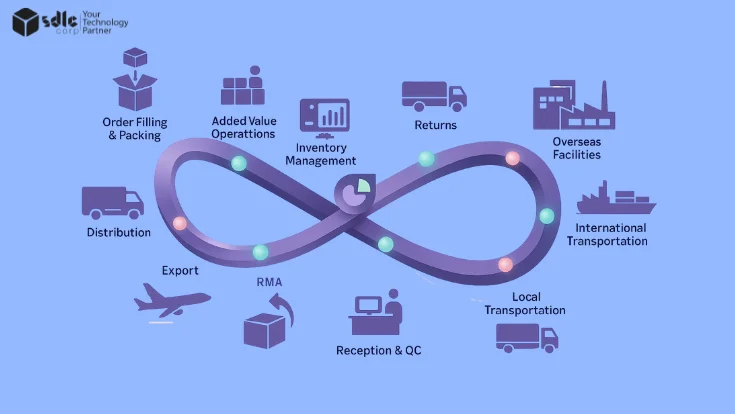Introduction
Cryptocurrency exchanges have emerged as critical players in the financial world, serving as the primary gateway for millions of users to buy, sell, and trade digital assets. These platforms have evolved significantly, leveraging various revenue streams and operational models to generate income and remain competitive in an increasingly crowded market. But how exactly do cryptocurrency exchanges make money, and what are the core elements of their business model? Let’s break it down.
If you’re considering entering the world of crypto exchanges, understanding the intricacies of the Cryptocurrency Trading Exchange Business Model is essential for long-term success.
Build Your Secure Crypto Exchange Today!
A Cryptocurrency Exchange Development Company specializes in building secure, scalable platforms for trading digital assets.

Core Components of the Cryptocurrency Exchange Business Model
Every cryptocurrency exchange operates with a set of core components that form the foundation of its business. These components ensure smooth operations, profitability, and user retention.
- Revenue Generation: How the exchange makes money.
- Liquidity Management: Ensuring there are enough assets to facilitate trades.
- Security Protocols: Protecting user funds and data.
- Compliance and Regulations: Adhering to local and international laws.
- User Acquisition and Retention: Strategies to attract and keep traders on the platform.
These elements are non-negotiable for any successful crypto exchange. Let’s take a closer look at how they fit into the broader business model.
1. Revenue Streams: How Crypto Exchanges Make Money
At the core of any cryptocurrency exchange’s business model is its ability to generate revenue. There are several ways these platforms monetize their services, and the most common are outlined below:
Trading Fees
The primary revenue source for most cryptocurrency exchanges is the trading fee. Each time a user executes a trade, the exchange takes a small percentage as a fee. This can either be a flat fee or based on the volume of the trade.
- Maker-Taker Model: Many exchanges use this model to differentiate fees for makers (users who add liquidity by placing limit orders) and takers (users who remove liquidity by filling existing orders). Typically, takers pay higher fees than makers.
Type of Fee | Who Pays It | Purpose |
Maker Fee | User placing a limit order | Provides liquidity to the exchange |
Taker Fee | User executing an existing order | Reduces liquidity, fills order from the book |
Listing Fees
Exchanges charge projects a listing fee to have their tokens listed on the platform. These fees can be substantial, particularly for popular exchanges, as getting listed often brings immediate exposure to millions of traders.
- Why It’s Important: For newer cryptocurrency projects, getting listed on a major exchange can provide liquidity and increase their token’s visibility. Exchanges capitalize on this by charging projects for the opportunity.
Withdrawal Fees
While trading fees generate significant revenue, exchanges also make money by charging users for withdrawing funds from the platform. This fee often covers the cost of network transactions (e.g., gas fees) and generates a margin for the exchange.
- Flat Fee vs. Percentage: Some exchanges charge a flat fee, while others charge a percentage based on the withdrawal amount.
Margin Trading and Lending Fees
Many exchanges offer margin trading, where users can borrow funds to leverage their positions. In return, the exchange charges interest on the borrowed funds. Similarly, some platforms offer crypto lending services, allowing users to lend their assets to earn interest while the exchange takes a cut.
- Interest Revenue: Exchanges generate interest by lending assets to traders or other users who wish to borrow cryptocurrency.
2. Liquidity Management: Ensuring Seamless Trading
Liquidity is the backbone of any successful exchange. Without sufficient liquidity, trades can’t be executed efficiently, and users may experience slippage—when the price of an asset changes between the time an order is placed and the time it’s executed.
- Liquidity Providers: Many exchanges rely on market makers or liquidity providers to maintain high liquidity. In return, these liquidity providers earn a portion of the trading fees.
- Order Book vs. Liquidity Pools: Traditional exchanges use order books, where buyers and sellers place their orders, while decentralized exchanges (DEXs) often use liquidity pools, where users provide assets for others to trade against.
Liquidity Model | Description |
Order Book | Lists buy and sell orders; trades are executed when there’s a match. |
Liquidity Pools | Funds contributed by liquidity providers are used to enable trades on decentralized exchanges. |
Start Your Centralized Exchange Today!
Develop a secure, scalable centralized crypto exchange with advanced trading features, liquidity solutions, and user-friendly UI.

3. Security: The Cornerstone of Trust
Security is paramount in the cryptocurrency exchange business model. Exchanges handle billions in digital assets, making them prime targets for hackers. A breach can destroy an exchange’s reputation and lead to significant financial losses.
Cold Storage
Most reputable exchanges use cold storage to store the majority of their users’ funds. Cold storage refers to keeping cryptocurrencies offline, away from internet access, making them far less vulnerable to hacking attempts.
- Cold Wallets: These are hardware wallets or other offline storage methods.
- Hot Wallets: Funds in hot wallets are used for day-to-day transactions but are more vulnerable to online attacks.
Two-Factor Authentication (2FA)
Security protocols such as 2FA are essential. Users are required to provide two forms of identification typically a password and a time-based code sent to their mobile device—before accessing their accounts or withdrawing funds.
Regular Audits and Penetration Testing
Exchanges that prioritize security often conduct regular security audits and penetration testing to identify vulnerabilities in their systems.
4. Compliance and Regulatory Adherence
Cryptocurrency exchanges are subject to an evolving regulatory landscape. Depending on the jurisdiction, exchanges may need to comply with strict regulations to operate legally.
Know Your Customer (KYC) and Anti-Money Laundering (AML)
Many centralized exchanges are required to implement KYC and AML protocols. These require users to verify their identities and prevent illegal activities like money laundering.
- KYC Process: Users must provide personal information and identity documents before they can trade or withdraw large sums.
- AML: Exchanges monitor transactions for suspicious activity and may be required to report it to regulatory authorities.
Licensing
To operate in certain regions, cryptocurrency exchanges must obtain licenses from local regulatory bodies. The level of scrutiny varies depending on the country, with some regions requiring extensive reporting and operational standards.
Region | Licensing Requirement |
United States | Must comply with SEC, FinCEN, and CFTC regulations. |
European Union | Compliance with GDPR and national financial laws. |
Singapore | Must be registered with the Monetary Authority of Singapore (MAS). |
5. User Acquisition and Retention
Success for any cryptocurrency exchange hinges on its ability to attract and retain users. With competition growing every day, exchanges need strong strategies to stay relevant in the market.
Referral Programs
Many exchanges offer referral programs, rewarding users for bringing in new traders. This helps grow the user base organically.
Loyalty Programs
Some platforms implement loyalty programs, where users can receive reduced fees or other perks by holding the platform’s native token or trading a certain volume.
Staking and Yield Farming
Exchanges that offer staking or yield farming give users opportunities to earn passive income, keeping them engaged and invested in the platform.
Business Model Summary
Aspect | Description |
Revenue Generation | Trading fees, listing fees, withdrawal fees, margin trading fees, and lending interest. |
Liquidity Management | Market makers or liquidity providers ensure smooth trades without slippage. |
Security Protocols | Cold storage, 2FA, regular audits, and penetration testing to secure user funds. |
Regulatory Compliance | KYC/AML requirements, regional licenses, and strict adherence to local regulations. |
User Acquisition/Retention | Referral programs, staking, yield farming, and loyalty programs to attract and maintain a user base. |
Maximize Profits with Crypto Arbitrage!
A crypto arbitrage bot is an automated trading tool that exploits price differences across various cryptocurrency exchanges, enabling traders to buy low on one platform and sell high on another for quick profits.

Conclusion: The Crypto Exchange Business Model in Motion
Running a cryptocurrency exchange is no small feat. Between managing liquidity, securing funds, adhering to regulations, and continuously engaging users, the business model of a crypto exchange is both complex and dynamic. With various revenue streams, from trading fees to listing charges, and the constant need for top-tier security and compliance, exchanges are built on a foundation of trust, efficiency, and profitability.
As the cryptocurrency landscape continues to evolve, exchanges that prioritize liquidity, user experience, and security will remain at the forefront. Understanding these components is key to operating a successful platform and navigating the competitive world of cryptocurrency trading.
How SDLC CORP Can Help with Cryptocurrency Exchange Development?
SDLC Corp specializes in cryptocurrency exchange software development, offering end-to-end solutions for businesses looking to enter the crypto market. Our expertise in crypto exchange software development includes the creation of robust and scalable platforms, ensuring secure transactions and seamless user experiences. As a leading white label cryptocurrency exchange development company, we provide white label exchange solutions that allow businesses to quickly launch customized exchanges with minimal time and cost. We also offer p2p crypto exchange software development for peer-to-peer trading platforms, along with advanced crypto derivatives exchange development for more complex financial instruments like futures and options. For decentralized platforms, SDLC Corp excels in decentralized exchange development, providing secure and efficient solutions for decentralized exchange crypto trading. Our team also offers innovative DeFi exchange development services, integrating decentralized finance into exchange platforms. Additionally, we specialize in crypto arbitrage bot development, creating automated tools like an arbitrage bot to capitalize on price differences across multiple exchanges, optimizing trading strategies for better profitability.

















